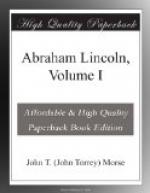and he saw with disquietude that it was being approached
too rapidly. He was getting sufficient knowledge
of McClellan’s character to see that the day
was not distant when he must interfere. Meantime
he kept his sensitive finger upon the popular pulse,
as an expert physician watches a patient in a fever.
With the growth of the impatience his anxiety grew,
for the people’s war would not be successfully
fought by a dissatisfied people. Repeatedly he
tested the situation in the hope that a movement could
be forced without undue imprudence; but he was always
met by objections from McClellan. In weighing
the Northern and the Southern armies against each
other, the general perhaps undervalued his own resources
and certainly overvalued those of his opponent.
He believed that the Confederate “discipline
and drill were far better than our own;” wherein
he was probably in error, for General Lee admitted
that, while the Southerners would always fight well,
they were refractory under discipline. Moreover,
they were at this time very ill provided with equipment
and transportation. Also McClellan said that
the Southern army had thrown up intrenchments at Manassas
and Centreville, and therefore the “problem
was to attack victorious and finely drilled troops
in intrenchment.” But the most discouraging
and inexplicable assertion, which he emphatically
reiterated, concerned the relative numerical strength.
He not only declared that he himself could not put
into the field the numbers shown by the official returns
to be with him, but also he exaggerated the Southern
numbers till he became extravagant to the point of
absurdity. So it had been from the outset, and
so it continued to be to the time when he was at last
relieved of his command. Thus, on August 15, he
conceived himself to be “in a terrible place;
the enemy have three or four times my force.”
September 9 he imagined Johnston to have 130,000 men,
against his own 85,000; and he argued that Johnston
could move upon Baltimore a column 100,000 strong,
which he could meet with only 60,000 or 70,000.
Later in October he marked the Confederates up to
150,000. He estimated his own requirement at a
“total effective force” of 208,000 men,
which implied “an aggregate, present and absent,
of about 240,000 men.” Of these he designed
150,000 as a “column of active operations;”
the rest were for garrisons and guards. He said
that in fact he had a gross aggregate of 168,318,
and the “force present for duty was 147,695.”
Since the garrisons and the guards were a fixed number,
the reduction fell wholly upon the movable column,
and reduced “the number disposable for an advance
to 76,285.” Thus he made himself out to
be fatally overmatched. But he was excessively
in error. In the autumn Johnston’s effective
force was only 41,000 men, and on December 1, 1861,
it was 47,000.[152]




